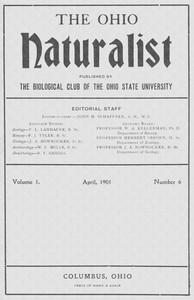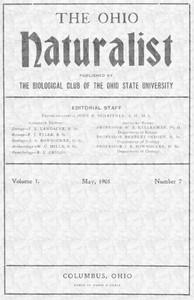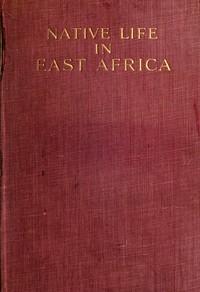|
|
Read this ebook for free! No credit card needed, absolutely nothing to pay.Words: 14848 in 7 pages
This is an ebook sharing website. You can read the uploaded ebooks for free here. No credit cards needed, nothing to pay. If you want to own a digital copy of the ebook, or want to read offline with your favorite ebook-reader, then you can choose to buy and download the ebook. Entered at the Post Office at Columbus, Ohio, as second class matter. PUBLISHED BY THE BIOLOGICAL CLUB OF THE OHIO STATE UNIVERSITY THE LAKE LABORATORY. HERBERT OSBORN. Most readers of the NATURALIST are probably aware that the University maintains at Sandusky a lake laboratory, devoted to the investigation and study of the life of the lake region. As this number of the NATURALIST is devoted mostly to reports upon work which has been done there, it may be of interest to give some facts regarding opportunities offered and the character of the work provided for. The laboratory was first opened by Professor Kellicott in 1895, with a view specially to give opportunity for investigation, and he and several of his students engaged in work there through the summers of '95-6-7. Some of the results of these studies were published, especially Professor Kellicott's report upon the Rotifers of Sandusky Bay and the list of Odonata for the State, which includes numerous records for that locality. During the summer of 1899 the writer and several associates occupied the laboratory, and studies upon the fishes of the locality, records of Hemiptera and some other groups have been incorporated in different papers. In 1900 the scope of the laboratory was enlarged so as to provide courses of instruction in Botany and Zoology, and a number of students and investigators improved the opportunity to work during the summer vacation. Reports on the Odonata, sponges, Bryozoa, and the notes on birds appearing in the present issue indicate the range of the studies engaged in that season. However, many lines of study which were begun by different students and which will require several seasons for observations, are not as yet ready for publication. It may be noted, however, that the flora of the locality has been very thoroughly collected by Professor Moseley, of the Sandusky High School, and his publication on the "Sandusky Flora" furnishes an admirable guide to the location of the various species of plants, and an excellent basis for additional investigation. The laboratory will at present accommodate twenty-five or thirty students, and its capacity will doubtless be increased as necessity requires. It is a two-story frame building 22 x 66 feet, the upper floor of which is used for investigation and the lower in part for students' laboratory tables. It is supplied with city water, a number of aquaria, has a convenient dark room for photographic work, and answers admirably for the purpose for which it is used--that is, for a temporary summer laboratory. The laboratory is supplied with two boats equipped with sails, and designed especially for work in the bay and marshes. Dredges, seines, plankton net and other collecting apparatus are provided, while microscopes, microtomes, books, and other laboratory equipments are taken from the university. While under the management of the Ohio State University, it is desired to make the laboratory as useful as possible to instructors and investigators in biology, wherever located. To this end table room is granted free of charge to qualified investigators, and any one wishing to undertake investigation of biological problems will be given all possible opportunity. Courses of study have been designed especially for high school teachers and for advanced university students, the former devoting themselves to methods of field work and preservation of material for laboratory use, and acquiring methods of laboratory work in connection with study of typical forms. For the latter, advanced courses in embryology, morphology, entomology, plant ecology, botany, etc., are offered. The students taking such courses can secure for them university credits covering equivalent courses in the university curriculum. It is needless to say that the opportunities for field observation, collecting, and the laboratory study of representative forms are most favorable. For special advanced courses in embryology, and particularly those pertaining to microscopical technique, the more elaborate equipment of the university is of course preferable. NOTES ON THE FLORA OF SANDUSKY. W. A. KELLERMAN. The visitor or student at the Lake Laboratory will find in the neighborhood of Sandusky a flora in many respects peculiar and richer in species perhaps than in any other region of similar area in the state of Ohio. For our knowledge of the Sandusky plants we are indebted mainly to the continued and energetic explorations of E. L. Moseley, teacher of botany in the Sandusky High School. Our visits to the region have been numerous, and many weeks have been spent in herborizing during the last few seasons. Mr. Moseley's Sandusky Flora and additions by myself and Mr. Griggs reported before the Academy of Science, and published in THE OHIO NATURALIST, Vol. 1, fully represent our knowledge of this interesting flora to date. In the "Sandusky Flora," page 2, Mr. Moseley states that "the surpassing richness of the Sandusky flora is not due to the fact that it includes islands within its territory, for scarcely any of its species are confined to the islands; nor is it in a very large measure due to the fact that it includes species that are confined to the lake shore; but rather to peculiarities of climate and geological features, both of which depend to some extent on the proximity of the lake." Free books android app tbrJar TBR JAR Read Free books online gutenberg More posts by @FreeBooks
|
Terms of Use Stock Market News! © gutenberg.org.in2025 All Rights reserved.







